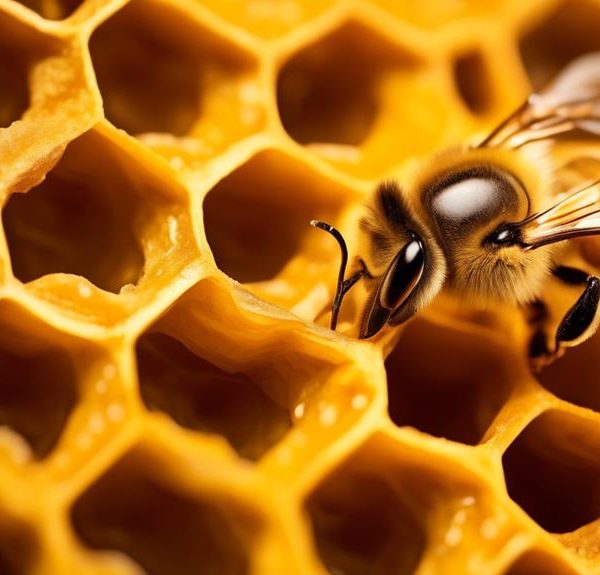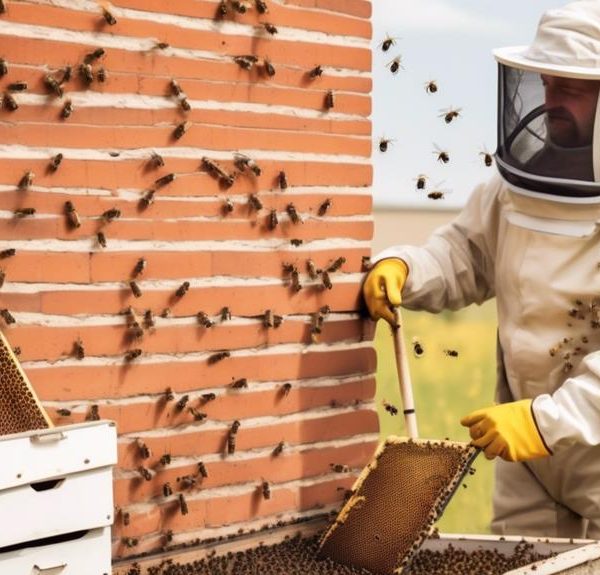Observe the intriguing process of bee reproduction and the queen bee's integral role in laying eggs.
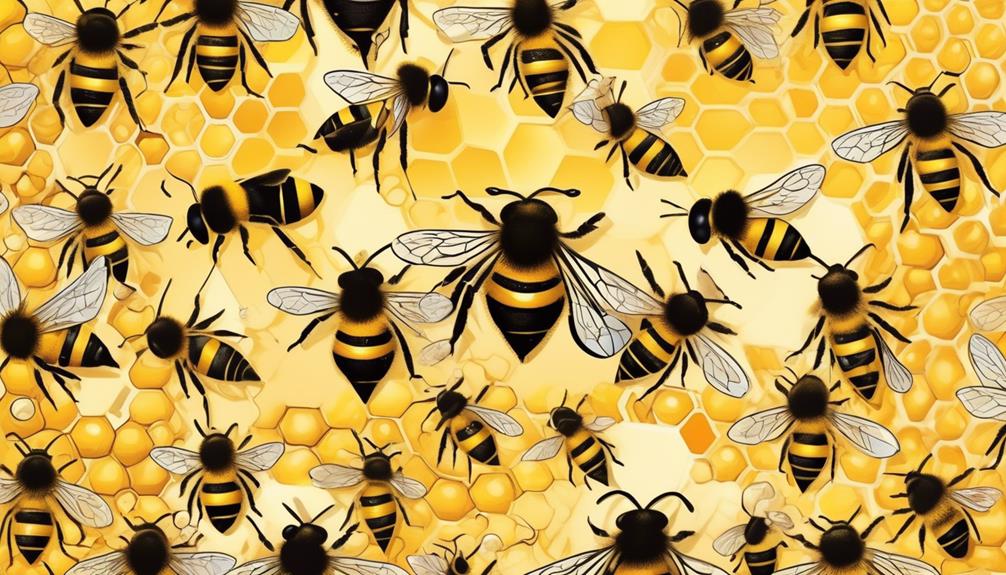
How Do Bees Lay Eggs?
Imagine standing in the heart of a buzzing beehive, surrounded by thousands of industrious insects, each playing a key part in the survival of their colony.
You're curious about the queen bee, aren't you? The most important member of the hive, the queen bee, has a unique and fascinating role, particularly when it comes to laying eggs.
But how does this process actually work? As you navigate through this discussion, you'll uncover the intriguing facts behind bee reproduction and the queen bee's crucial contribution to the continuation of her species. You might even find yourself surprised at the complexity of these seemingly simple creatures.
Key Takeaways
- Bees live in colonies led by a single queen who is responsible for laying eggs.
- The queen mates with multiple drones during her nuptial flight to store sperm for future egg fertilization.
- Worker bees, which are all female, usually do not lay eggs, but in the absence of a queen, some may lay unfertilized eggs that develop into drones.
- The diet of bee larvae determines their future role in the colony.
Understanding Bee Reproduction
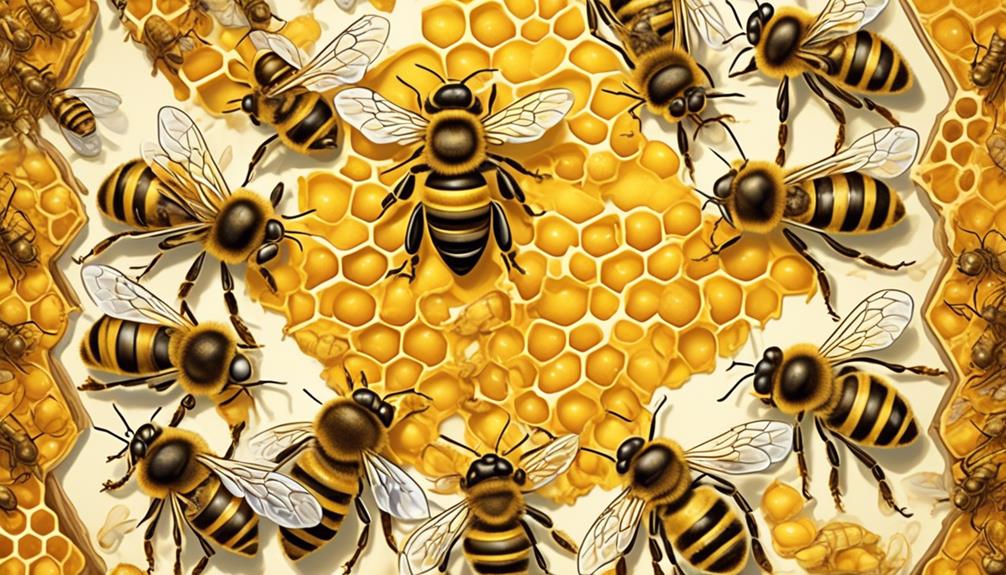
To fully grasp how bees lay eggs, it's crucial to first understand their unique and complex reproductive process. Now, you might know that bees live in colonies led by a single queen, but did you know only the queen can lay eggs? That's right. In a hive, the queen, drones, and workers each have distinct roles in reproduction.
The queen bee, after mating with several drones during her nuptial flight, stores millions of sperm in her spermatheca. This allows her to lay fertilized eggs throughout her life, which can last 3-5 years. She's a real egg-laying machine, producing up to 2000 eggs per day! These fertilized eggs will develop into workers or a new queen as needed.
On the other hand, drones exist solely to mate with the queen. They're the only males in the colony and don't possess a stinger. Once they've fulfilled their purpose, they're driven out of the hive or die immediately after mating.
Lastly, worker bees, which are all female, don't usually lay eggs. However, in a queenless hive, some may lay unfertilized eggs, which develop into drones. Thus, understanding the roles of different bees is key to comprehending how bees lay eggs.
The Queen Bee's Role
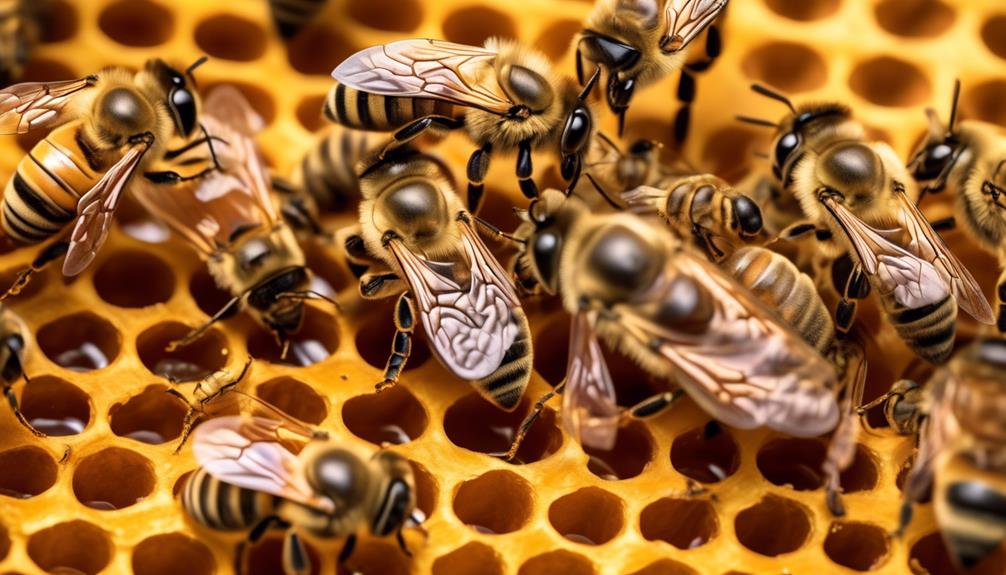
Now that you've got a grasp on the basic roles within a bee colony, let's zero in on the queen bee and her pivotal function in egg-laying.
The queen bee is the mother of all bees in a hive, with her primary role being to lay eggs. She's the only female in a colony with fully developed sexual organs.
After her nuptial flight, where she mates with multiple drones, she's equipped with enough sperm to lay fertilized eggs for the rest of her life. She can lay up to 2,000 eggs per day, which is more than her own body weight. These eggs are laid in the honeycomb cells, where worker bees will feed and care for the larvae that hatch.
The queen decides whether to fertilize an egg or not. If fertilized, it will develop into a worker bee (female). If not, it becomes a drone (male). This choice depends on the needs of the colony.
In essence, the queen bee's role is crucial for the survival of the colony. She's not just a figurehead, she's the key to perpetuating the hive's population, ensuring the colony's longevity and viability.
The Mating Process
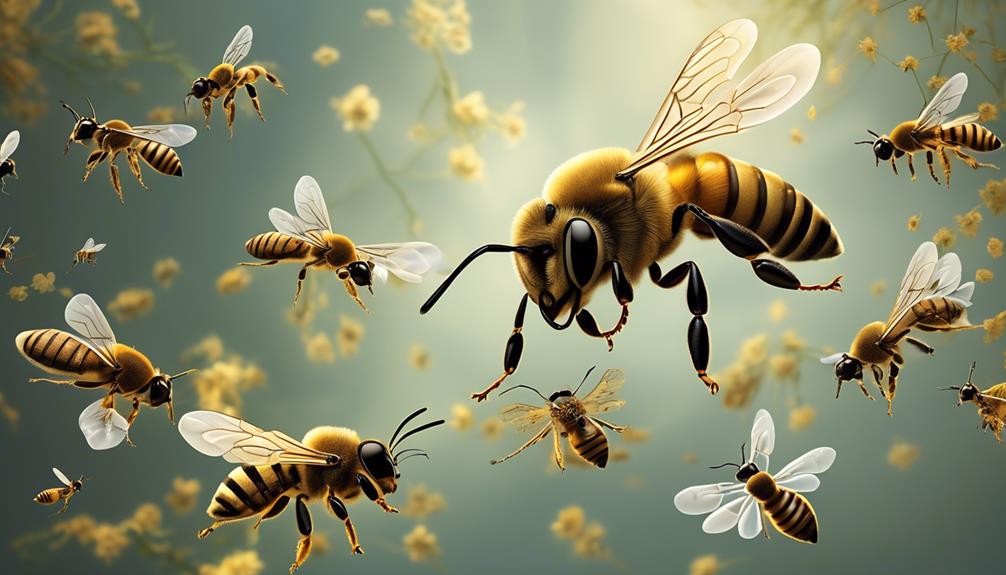
Before delving into the intricacies of bee reproduction, it's crucial to understand that the mating process is a one-time event in the queen bee's life, occurring during her maiden flight. This flight usually takes place a few days after she emerges as an adult, when she'll leave the hive to mate with multiple drones in flight.
These drones are male bees, whose primary role is to fertilize the queen's eggs. They're attracted to the queen by her pheromones and will mate mid-air, in a process known as a mating flight. Tragically, this act is fatal for the drone, as his reproductive organs are torn from his body during copulation, leading to his death.
Once the queen has mated with several drones, she returns to the hive, carrying enough sperm to fertilize her eggs for the rest of her life. It's an astonishing fact that a queen can lay up to 2,000 eggs a day, and she's able to control whether each egg is fertilized or not. This control enables her to determine the sex of her offspring, producing either worker bees or new drones.
From Egg to Larvae
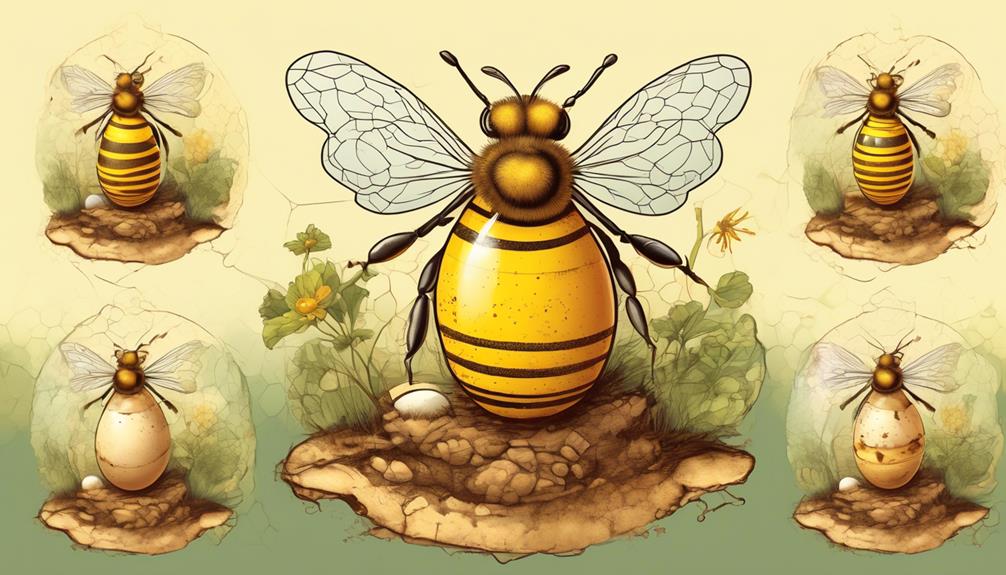
Having understood the queen bee's remarkable egg-laying ability and the role of the drone in fertilization, let's examine the fascinating journey these eggs undertake from inception to larvae stage.
Once the queen bee lays her eggs, she deposits them into the cells of the honeycomb structure. Each egg is meticulously placed upright by the queen, adhering to the cell's base. They remain in this position for about three days, during which they're nourished by worker bees.
After three days, a significant transformation takes place. The eggs hatch into tiny, worm-like larvae. These larvae are helpless and can't move, but they grow rapidly, thanks to the constant feeding by the workers.
You'll find it intriguing to know that the diet of these larvae determines their future role in the bee colony. Worker larvae are fed a mixture of pollen and nectar known as 'bee bread', while potential queen larvae are given 'royal jelly', a protein-rich secretion from the worker bees' glands.
Through this meticulously coordinated effort, the bee colony ensures the continuous growth and survival of their species. The journey from egg to larvae is indeed a marvel of nature's design.
Lifecycle of an Adult Bee
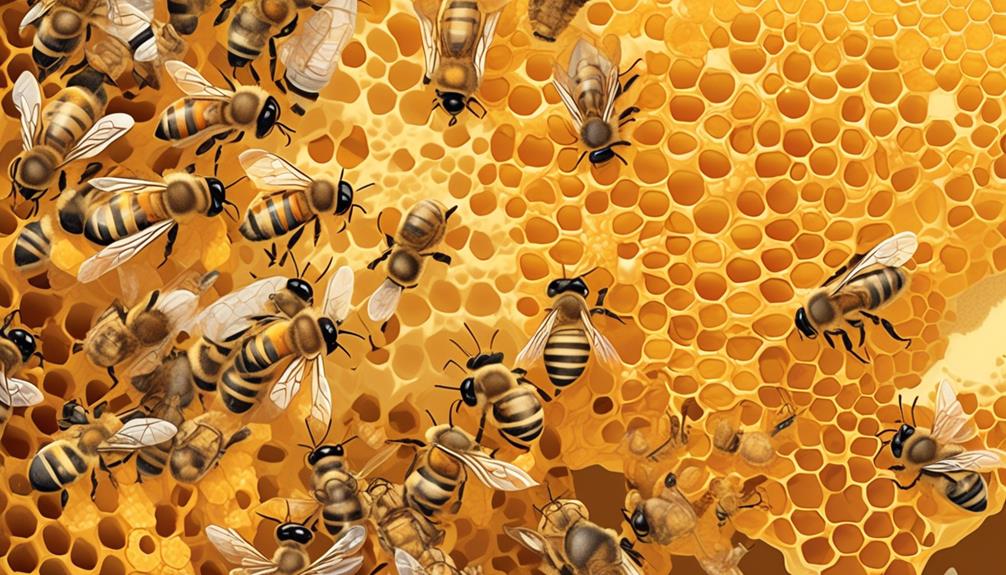
After the fascinating transformation from egg to larvae, a bee's life journey continues with the transition into adulthood, a process filled with critical changes and responsibilities within the hive. As an adult bee, you'd find yourself engaged in various tasks, depending on your sex and species.
A female worker bee, you'd spend your early days cleaning cells, feeding larvae, and attending to the queen. As you age, you'd move onto tasks outside the hive, such as foraging for nectar and pollen, or protecting the hive. You'd do all this while your biological clock ticks rapidly, with a lifespan of only six weeks in the summer.
If you're a drone, your sole purpose is to mate with a queen. Once you've fulfilled this duty, your life comes to an abrupt end.
And if you're a queen bee, you're the hive's heart and soul. Your main duty is laying eggs, which you'd do at an impressive rate of up to 2,000 a day during peak season. But remember, you'd also maintain harmony in the hive by releasing pheromones that keep worker bees cooperative and productive. This is your life as an adult bee – short but vital.
Frequently Asked Questions
What Are Some Common Diseases That Can Affect the Egg-Laying Process in Bees?
You're inquiring about diseases that can disrupt bees' egg-laying process.
Notably, Nosema disease, caused by a gut parasite, can drastically impair a queen bee's ability to lay eggs.
American and European Foulbrood are bacterial diseases that directly infect bee larvae and brood, affecting the overall population.
Then there's Varroa destructor mites, which weaken bees and spread viruses, potentially impacting the queen's egg-laying ability.
Each of these pose significant threats to bee colonies.
How Does Climate Change Impact the Reproduction Cycle of Bees?
Climate change can disrupt the reproduction cycle of bees. Warmer temperatures can lead to earlier springs, causing a mismatch between when plants bloom and when bees are ready to pollinate and lay eggs. If it's too hot, bees mightn't lay eggs at all.
Also, extreme weather events could wipe out whole colonies. You're seeing a ripple effect on the ecosystem because bees play a crucial role in pollination.
How Can Humans Support the Egg-Laying Process in Bees?
You can support bees' egg-laying process by planting diverse flowering plants in your garden. Bees need a variety of pollen and nectar sources for optimal health.
You should also avoid using pesticides, as they're harmful to bees. Providing a bee-friendly habitat, like a bee house, can also help.
How Does the Bee's Diet Affect Its Ability to Lay Eggs?
You're curious about the bee's diet and its impact on egg-laying.
Well, a bee's diet greatly influences its ability to lay eggs. If the queen bee doesn't get enough protein from pollen, she can't produce eggs. Similarly, worker bees need nectar for energy to care for the eggs. So, without a balanced diet, the bee's egg-laying process suffers.
It's like you and me; without proper nutrition, we can't function at our best.
What Are the Differences Between How Bees and Other Insects Lay Eggs?
Unlike other insects, bees have a unique method of laying eggs. Queen bees lay fertilized or unfertilized eggs based on the hive's needs. Fertilized eggs become female worker bees or potential future queens, while unfertilized eggs develop into male drones. Most other insects don't exhibit such control over their offspring's sex.
Additionally, bee eggs are laid in wax cells, which isn't common among other insects.
Conclusion
So, you've journeyed through the fascinating world of bee reproduction. You've discovered the vital role of the queen bee, experienced the unique mating process, and traced the journey from egg to larvae.
You've even explored the lifecycle of an adult bee. It's clear now, isn't it? Bees are intricate, well-organized insects with a complex reproductive system that ensures their survival. Every stage, every role, is a testament to the marvel of nature's design.

